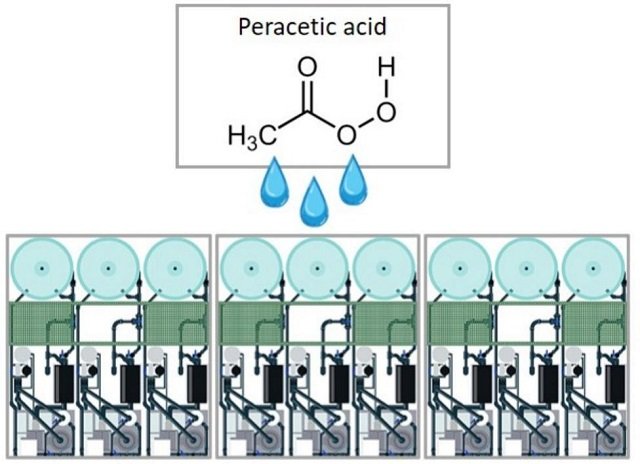Norway – New research shows that land-based recirculation facilities for salmon farming in Norway and in North America are disinfected in different ways. An overall picture of current practice may provide knowledge that increases safety in a rapidly growing industry.
Nofima scientist Carlo C. Lazado and Chris Good of The Conservation Fund’s Freshwater Institute recently released the scientific publication ‘Survey findings of disinfection strategies at selected Norwegian and North American land-based RAS facilities: A comparative insight’.
More effective and less disease
The publication, which is based on responses to a survey, shows differences and similarities in the disinfection of equipment at 25 modern RAS facilities in Norway and North America (US and Canada). The knowledge can be used to create new standards to increase effectiveness and prevent outbreaks of disease.
There are strict hygiene standards in land-based facilities. Disinfection is an important safety measure that prevents the spread of pathogens, which can cause disease in the fish.
“In Norway, the production of salmon in RAS facilities is increasing rapidly, which is why we are now evaluating current practices so that the industry has a basis on which to adjust future procedures”, says Carlo C. Lazado.
Many use standard protocols
The first part of the survey is about general disinfection strategies for equipment. The majority of Norwegian respondents, and more than 90 percent of the North American respondents, state that they use standardised protocols when disinfecting. In other words, they follow the manufacturer’s recommendations for use.
“Many factors influence how effectively the equipment is disinfected, such as the type of materials, temperature and humidity. A disinfectant product must be practically tested in several facilities in order to find out how effective it is under varying conditions. The survey reveals that many people are not aware of how effective the disinfectant is for their RAS facility”, says Lazado.
Stay Always Informed
Join our communities to instantly receive the most important news, reports, and analysis from the aquaculture industry.
Must be effective against pathogens
The scientists then asked what type of disinfectants are used at the facilities, and why. The answers show that a number of different disinfectants are used in all facilities. In Norway, peracetic acid-based disinfectant is mainly used, but also chlorine. In North American facilities, chlorine and sodium hypochlorite is predominantly used. The difference may be due to the fact that far more products based on peracetic acid are approved in Norway, compared to those based on chlorine. All the respondents stated that effectiveness against pathogens and user safety are the main criteria regarding the choice of agent.
North Americans disinfect more frequently
Part three of the survey is about the disinfection of equipment in the facilities.
Approximately 40 percent of Norwegian respondents state that they disinfect tanks and pipes after each production cycle, while 60 percent of North American respondents do the same.
The period of contact with the disinfectant varies between 12 and 24 hours at the Norwegian facilities, while there are greater variations in North America. There, the period of contact is from 1 to 24 hours.
“Greater variation in the period of contact may indicate that they have more structured strategies, and somewhat more experience regarding the effect of disinfection. This is reflected in the fact that most facilities in North America have longer operating time compared to the Norwegian ones”, says Lazado.
Necessary training is provided to employees
All the respondents stated that employees at the facilities receive the necessary training in the use of disinfectants and protective equipment, and that local regulations are followed. All the facilities have their own safety procedures, but there is no overview of how these procedures are practiced and managed.
The scientists conclude that RAS facilities in both Norway and North America can advantageously systematise their disinfection strategies.
“The results of the survey will be valuable for developing universal RAS disinfection guidelines”, says Lazado.
Contact person
Carlo C. Lazado
Scientist
Phone: +47 930 27 905
carlo.lazado@nofima.no
Reference (open access):
Carlo C. Lazado, Christopher Good. Survey findings of disinfection strategies at selected Norwegian and North American land-based RAS facilities: A comparative insight. Aquaculture, Volume 532, 2021, 736038, ISSN 0044-8486, https://doi.org/10.1016/j.aquaculture.2020.736038.
Source: NOFIMA
Editor at the digital magazine AquaHoy. He holds a degree in Aquaculture Biology from the National University of Santa (UNS) and a Master’s degree in Science and Innovation Management from the Polytechnic University of Valencia, with postgraduate diplomas in Business Innovation and Innovation Management. He possesses extensive experience in the aquaculture and fisheries sector, having led the Fisheries Innovation Unit of the National Program for Innovation in Fisheries and Aquaculture (PNIPA). He has served as a senior consultant in technology watch, an innovation project formulator and advisor, and a lecturer at UNS. He is a member of the Peruvian College of Biologists and was recognized by the World Aquaculture Society (WAS) in 2016 for his contribution to aquaculture.




